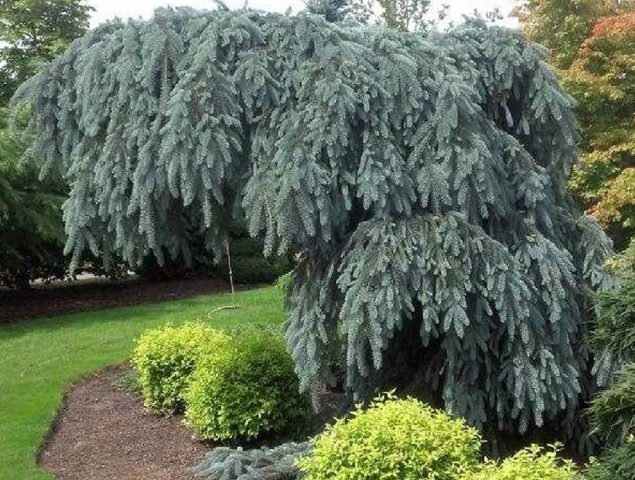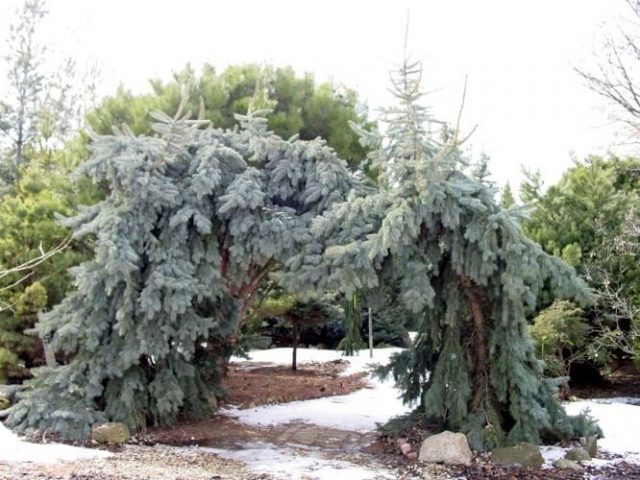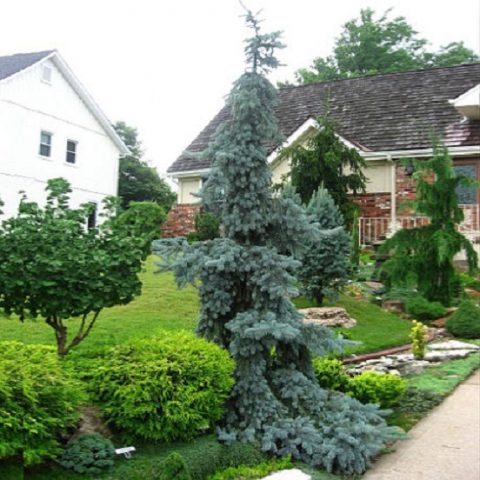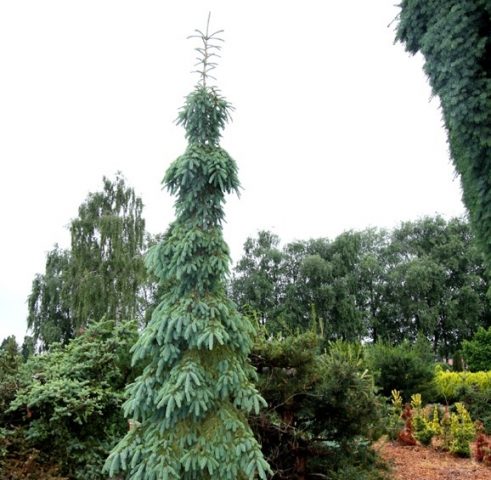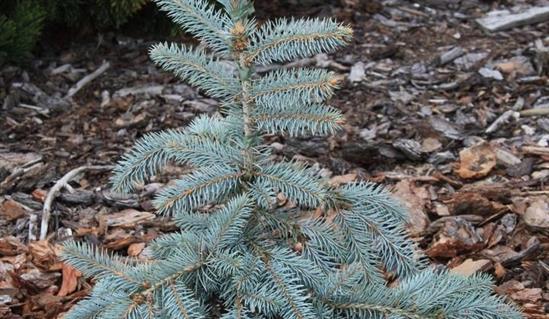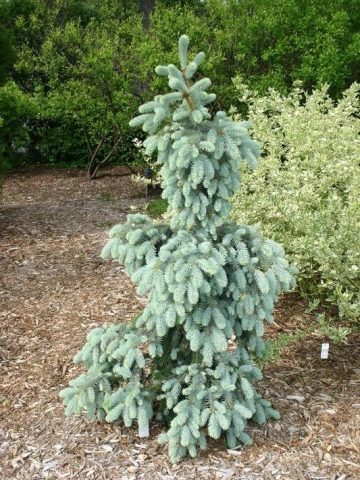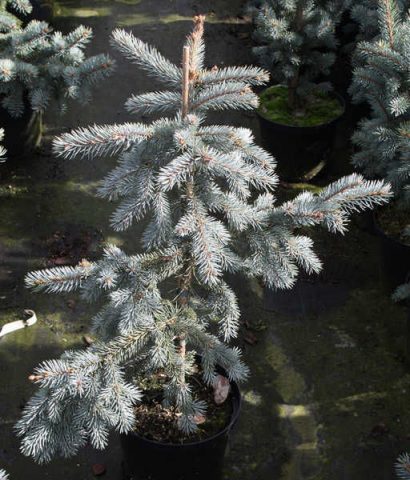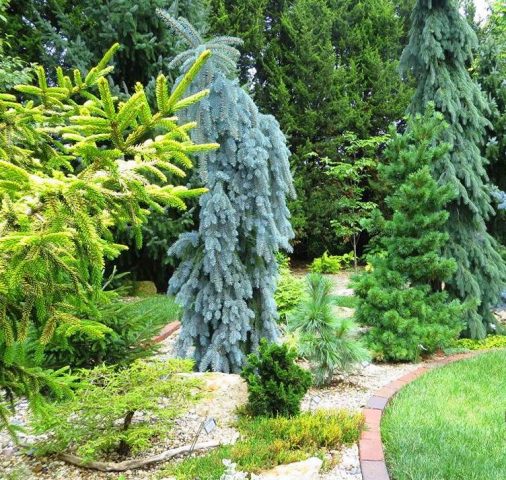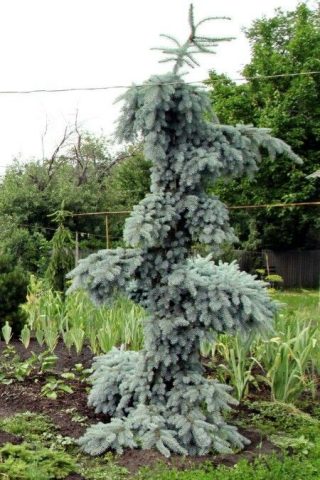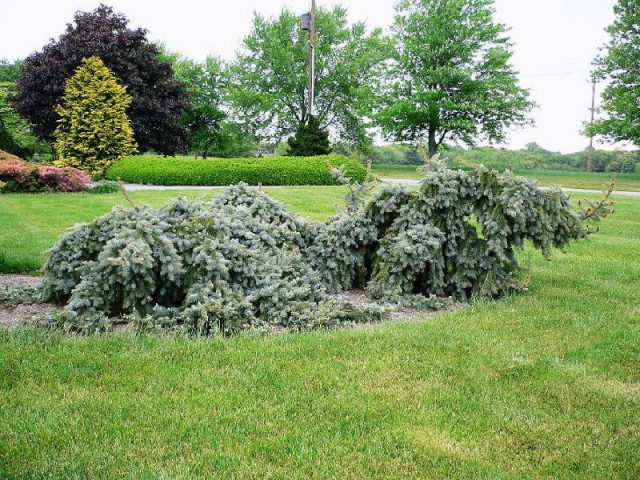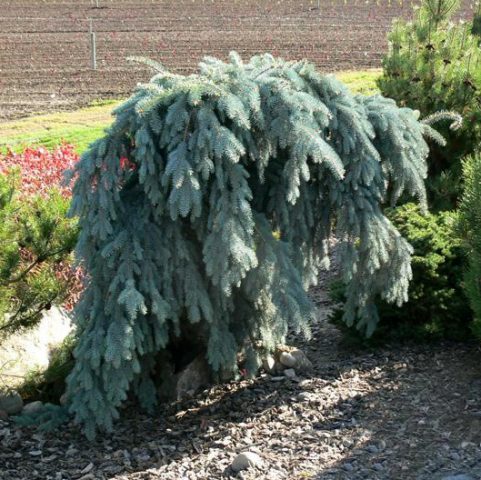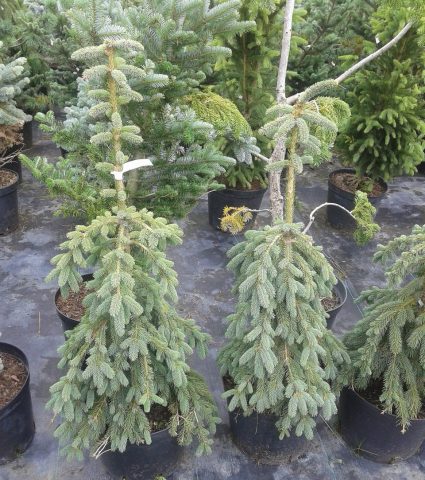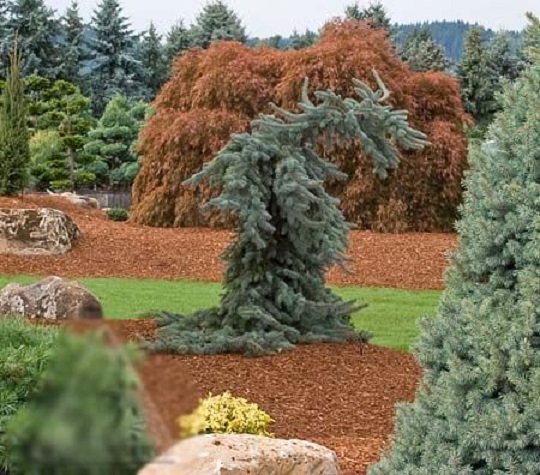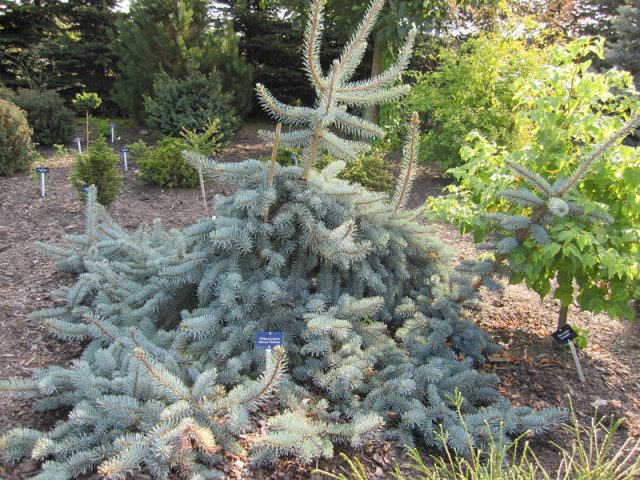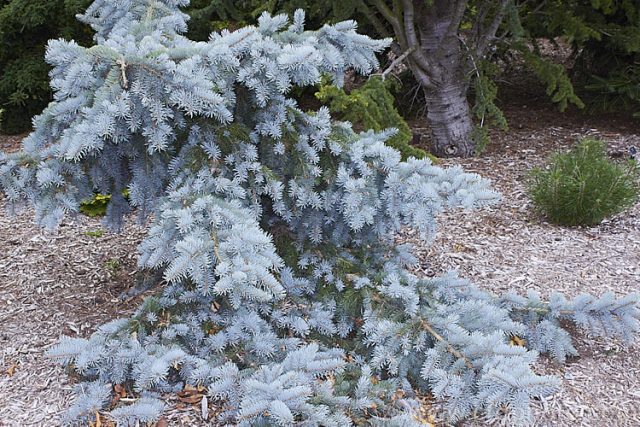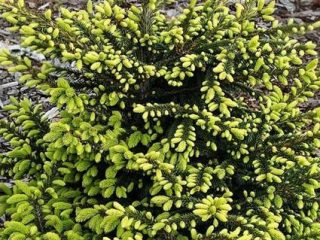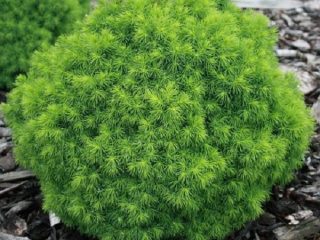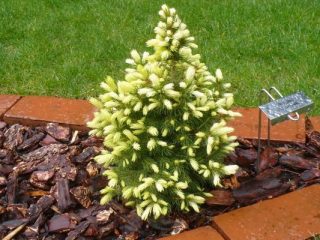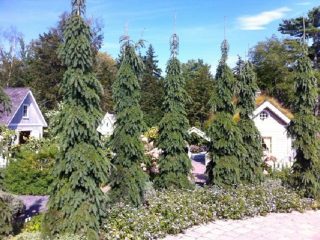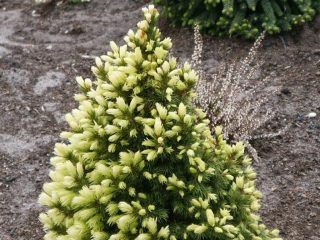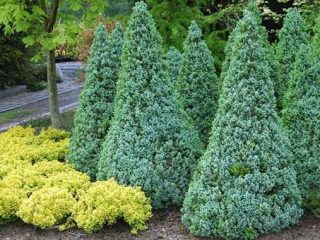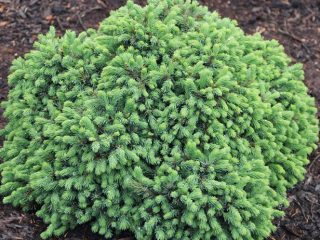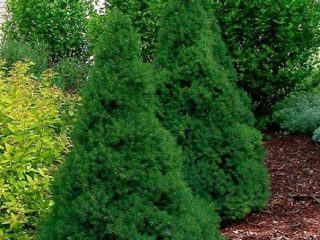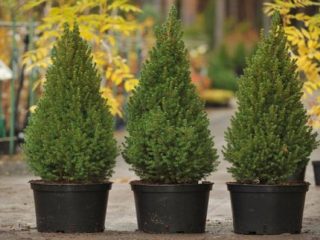Content
As part of the name of coniferous and deciduous plants, Pendula is found quite often, which confuses novice gardeners. Meanwhile, the word only means that the crown of the tree is weeping and drooping. Prickly spruce Glauka Pendula is one of the most beautiful coniferous crops, obtained as a result of somatic mutation, and propagated exclusively by grafting.
Description of the prickly spruce Glauka Pendula
The mutation that led to the creation of the prickly spruce variety Glauka Pendula was discovered in the Gardens of Versailles by A. Carrier. The plant was introduced into cultivation by Ari Koster, owner of the Boskop nursery (South Holland) in 1895.
Glauka Pendula is one of the most beautiful varieties of prickly spruce, considered medium-sized. It is propagated only by grafting, so most of the trees come to Russia from Poland, Holland, Germany and other foreign nurseries. Domestic producers have just begun to carry out the operation, and cannot saturate the market.Because of this, planting material is expensive.
The presence of the word Pendula in the name of the spruce variety itself means that its crown should be drooping and weeping. But it is not always the case. The fact is that the shape of the tree in this particular case depends on the owners, or rather, their desire or ability to give the plant the desired shape.
The prickly spruce Glauka Pendula does not have a trunk as such. Its role is played by a randomly selected powerful branch tied to a support. The owner himself is able to regulate the height of the Glauk Pendula. To do this, he stops tying up the prickly spruce, and then the top hangs, or he increases the support, and the tree continues to stretch upward.
As a result, you can get plants that differ greatly in height, shape and crown contours. That’s why the photos and descriptions of the Glauka Pendula spruce are so different.
The growth of an adult tree depends on the height of the graft and garter. Usually Glauka Pendula for small gardens is formed at 3-5 meters, in large areas it is allowed to stretch up to 8-10 m. But if this spruce is not tied up at low grafting at all, it will become like a ground cover plant. Only prickly.
Based on this, it is difficult to talk about the width of the Glauka Pendula spruce. If grown as a ground cover plant, it can cover a large area, especially since the shoots can take root in contact with the ground for a long time. But if you constantly raise the conductor at Glauk Pendula, and do not touch the side branches at all, the width of the prickly spruce can reach 1.5 m. This is a very relative value. Usually, owners use garters, trimmings and other methods to give the crown a bizarre shape.
Glauka Pendula grows quickly, under good conditions adding 30 cm during the growing season.Its branches are tough, but quite strong, capable of withstanding large masses of snow. The needles are dense, prickly, blue, slightly curved like a sickle, 15-20 mm long, do not change color throughout the season.
The shoots of Glauka Pendula fall in a thick, dense cascade, completely covering the trunk. The lower branches hang at an angle; if the branches are not trimmed, they fall to the ground. The higher the shoots are located, the more freely they are located. Some grow almost parallel to the ground surface for some time. Because of this, the tree takes on an original shape, and we can safely say that there are no two identical prickly spruce trees with a weeping crown.
Varieties
Spruce Pungens Glauka Pendula was obtained as a result of an unstable mutation; when it is grown, deviations in the color of the needles and the growth pattern of drooping branches constantly occur. Many of them have been propagated and separated into separate varieties.
In Russia, all weeping forms of prickly spruce are usually called simply Pendula, but in fact they are registered under various names. By and large, these are variations of the same variety; it can be difficult for amateurs to understand them, but there are still differences.
Experts are still arguing which name of the original form is correct: Prickly spruce Glauca Pendula or Kosteri Pendula. As a result, they decided that it was easier to consider them synonyms.
Spruce Pendula
The Pendula prickly spruce differs from the original variety only in the color of its needles. Its needles are not white-blue, like Glauka’s, but green. The crown is drooping, the lower branches are lowered at an angle and lie on the ground, the upper ones first grow in a horizontal plane, then fall down.The height depends on the place of grafting and the garter of the conductor to the support. The branches are tough, the needles are prickly. Only when permanently attached to the support, its width is slightly larger than that of Glauk Pendula - not 1.5, but 2 m.
El Argentea Pendula
The word Argentea itself shows that the needles of this prickly spruce are silver, and not green or blue. With the constant garter of the leader, from a distance she looks more like the Serbian Pendula. Closer examination shows that it is still a prickly spruce with hard, sharp needles.
If the conductor is directed only upward, the crown becomes narrowly conical, with drooping branches. Growth – 15-30 cm per season. The prickly Argentea Pendula variety has excellent frost resistance and can be grown without shelter in zone 2.
Prickly spruce Glauka Pendula Slenderina
The Pendula Celenderina Glauka spruce differs from the original variety in its more compact size and somewhat slower growth. In spring, its needles are silver-blue; in summer, the color of the needles returns to the blue-white color familiar to the mother form.
The central leader, Glauka Pendula Slenderina, grows straight, the lower branches form a kind of skirt around the trunk.
Spruce Pendula Wojslawice
The main difference between this Polish variety of prickly spruce and the original Pendula Glauka is the irregularly shaped crown and silvery needles. Even with constant gartering of the leader, its shoots tend not to fall in tiers, but stick out in different directions, hanging with age. In addition, the Wojsławice Pendula spruce will overwinter without shelter only in zone 4.
Prickly spruce Ze Blues Pendula
The new highly decorative variety of weeping prickly spruce has not yet been sufficiently propagated and is rare.It forms a low tree, with constant staking of the leader by the age of 10 reaching 1 m, at 25-30 years it will presumably stretch up to 3 m.
The needles of this prickly spruce are unusually bright, silver-blue in the sun, but fade in partial shade. The needles are noticeably larger than those of Glauk Pendula, but just as sharp and tough.
Spruce Pendula in landscape design
The spread of the Glauka Pendula variety of prickly spruce is limited only by its high cost, caused by the difficulty of reproduction. This beautiful tree with a drooping crown, stiff branches that can withstand large amounts of snow, blue needles, does not change color throughout the season and inspires the creation of beautiful compositions.
Glauca Pendula looks great as a tapeworm (single focal plant). Weeping prickly spruce is planted in the foreground of tree landscape groups. Pendula can decorate the front entrance to a house or recreation area. It will serve as an exotic accent among other conifers, emphasizing the charm of roses and other lush or modest flowers.
Thanks to the original crown, with the help of a garter and trimming from the prickly spruce Glauka Pendula, you can create:
- an unusual tall tree with a sharp, upward-pointing crown and branches pressed to the trunk, falling in narrow tiers;
- a wide ground cover plant occupying a large area with shoots lying on the ground, covered with hard, prickly needles of green, silver or blue color;
- a weeping low tree with a top strongly inclined in the direction desired by the designers, and a cascade of flowing long branches.
Using a bit of imagination, you can shape a weeping prickly spruce as you wish, creating new, unusual and unusual compositions. Pendula is well suited for landscape, romantic or mixed style gardens. It is difficult to fit it into a regular style, but competent landscape designers can do this.
Planting and caring for Pendula spruce
Caring for the prickly spruce of the Pendula form is not difficult, but must be careful due to grafting. If a disease occurs at the junction of the tissues of two different trees, pests “work”, frost breaks or any mechanical damage occurs, measures will need to be taken immediately. Otherwise, Pendula Glauka may die. The general condition of the tree depends on the correct regime of watering, fertilizing and other maintenance activities.
When planting, the Pendula prickly spruce has the same requirements as other coniferous crops.
Preparing seedlings and planting area
All Pendula thorny spruces grow well in full sun. In partial shade, nothing threatens their health, but blue or silver needles will become faded. There you can plant a variety with green needles - the usual Pendula. For the Ze Blues form, a lack of light is unacceptable, since the main beauty of the tree is in the unusually bright needles.
Prickly spruce trees are distinguished by a root system that extends to greater depths than other species. Because of this, they are less susceptible to wind blowing and can grow on sandy, dry soils. But this also makes it impossible to plant prickly spruces in hollows, on wet soils and where groundwater comes close to the surface.
Glauka Pendula loves acidic soil, but will grow in slightly acidic soil. Soils with neutral and alkaline reactions need radical improvement.Prickly spruce does not like heavy and dense soil.
The pit for prickly spruce must be prepared no later than 2 weeks before planting. Its width is made 1.5-2 times larger than the expected diameter of the earthen clod or container, and the depth is such that a drainage of 20-30 cm and a layer of substrate can fit.
The soil mixture is made from leaf humus, acidic peat, turf soil, 100-150 g of nitroammophoska and sand. Lay drainage, fill 2/3 of the hole with substrate, fill it with water and let it settle.
When purchasing Pendula prickly spruce, attention is first paid to the grafting site. It should be well healed, without visible damage or signs of disease. If possible, you need to buy seedlings from local nurseries. But you shouldn’t really hope to find them - most grafted spruce trees come from abroad.
Imported seedlings must be in a container; the root system of local ones, together with a lump of earth, can be covered with burlap. You should not even consider the possibility of purchasing a bare-root Glauka Pendula spruce.
The potting medium or burlap should be kept moist. Signs of drying out of the needles, even the tips of the needles that have changed color are a bad sign. You cannot buy such a spruce.
Landing rules
The prickly spruce Glauka Pendula, grown in a container, is planted throughout the season, except for the hot summer months. Burlap-lined trees are placed on the site in spring or autumn. In the southern regions, it is better to do this at the end of the season, so that the heat does not interfere with the rooting of spruce; in the north, in the spring. Then the tree will become accustomed to the onset of frost and take root on the site.
There is nothing complicated about planting the prickly spruce variety Pendula Glauka. It is carried out in the following sequence:
- Part of the substrate is removed from the planting hole and set aside.
- Spruce Glauka Pendula is installed in the center of the recess. The transition point from the root to the trunk (root collar) should be level or slightly above the edge of the hole.
- The prepared substrate is gradually filled with an earthen lump of spruce, tamping it down to avoid the formation of voids.
- From the remaining soil, a side approximately 10 cm high is formed around the planting hole.
- Water the seedling generously with water so that it reaches the edge of the fence.
- When the liquid is completely absorbed, add soil if necessary, mulch the tree trunk with pine bark or acidic peat.
Watering and fertilizing
After planting the prickly spruce, it needs to be watered frequently, not allowing the soil to dry out completely, even for a short time. But it is also impossible to over-moisten the soil, so as not to cause root rot.
When Glauka Pendula takes root, reduce watering - among other spruce trees, prickly spruce is resistant to short-term drought. Of course, the plant should not be left without water - it will weaken, lose turgor and become easy prey for insect pests. In the hot summer, Glauka Pendula is watered every week, spending at least 10 liters on a small prickly spruce; an adult tree will require a bucket of water for every meter of growth.
Sprinkling will benefit the plant. It is not as important as for dwarf Canadian spruce trees, but it must be carried out at least once a week in the summer.
Varietal plants should be fed with special fertilizers for coniferous crops. There, all the necessary substances are balanced by the manufacturer in the doses required for prickly spruce:
- in those intended for spring, nitrogen predominates;
- autumn ones contain large doses of potassium and phosphorus.
Foliar feeding allows the plant to receive the necessary microelements. It is useful to alternately add epin or zircon to the balloon - these drugs cost pennies, and their benefits can hardly be overestimated.
Balanced complete foliar feedings contain all the microelements necessary for the plant. It is often recommended to add an additional dose of magnesium to the container for treating conifers. For spruce trees with blue or silver needles, this should be abandoned. Magnesium enhances the green color of vegetative organs, which is clearly unnecessary for Glauk Pendula.
Mulching and loosening
You need to loosen the soil under newly planted spruce trees. After they take root, thin sucking roots come close to the surface. They should not be damaged by regular loosening.
Instead, the tree trunk circle is mulched with pine bark or high-moor peat - this acidifies the soil, protects the root from overheating, conserves moisture and prevents root penetration weeds.
Trimming
The beautiful crown of weeping prickly spruce trees does not need pruning. It is only necessary to remove broken or dried branches during sanitary measures. But the crop tolerates shearing well, so if the design of the site requires changing the shape of Glauka Pendula, it can be cut as you like.
You just need to trim it in early spring before the buds open, or, depending on the region, at the end of summer or beginning of autumn. Before the onset of cold weather, the wound surface should heal. From the end of May to the beginning of June, pinching of spruce trees is carried out, removing soft young shoots completely or partially.
How to display a conductor
The Pendula spruce in the photo always has a beautiful drooping crown shape.In practice, gardeners often complain that their tree does not grow as they would like. The fact is that Pendula Glauka cannot always form an attractive crown without outside help.
Trees of this variety do not have a trunk; its functions are taken over by a strong branch tied to a support. She is called a leader or guide. The height of the Glauc Pendula is adjusted by tying the conductor higher and higher. When the tree reaches the desired size, stop adding support. The top of the leader continues to grow, hanging lower and lower. This operation is called “leader removal.” Or conductor, it depends on which name you prefer.
In this case, the top can be directed in the desired direction, as well as the side branches. In order for them to bend in the desired direction, young shoots are simply tied at first to pegs driven into the ground. Over the course of a season, they will become woody, and they will grow “where they need to be.”
Using a garter, horizontal and vertical supports of different sizes from the prickly spruce Glauka Pendula, you can generally form a plant of fantastic shape. It will look strange for a while, surrounded by pieces of wood and rope, but the results will be worth a little patience.
If you don’t tie up a weeping spruce grafted onto a low trunk at all, it will scatter its branches over the ground and become like a ground cover plant or a low bush of a bizarre shape.
Preparing for winter
Prickly spruce trees are highly frost-resistant. Pendula forms can overwinter without shelter in zones 2-3, only the Polish variety Wojslawice is more thermophilic and is intended for zone 4.
Prickly spruce trees need to be protected from low temperatures only in the year of planting.In the North and other regions with cold climates, it is better to play it safe and wrap the tree in non-woven material for the second winter.
The location of the vaccination is another matter. If it is done efficiently and heals well, then there should be no problems. But still, it is better to wrap the graft, not covered by thick branches, with a strip of non-woven fabric in 1-2 layers when the temperature drops below -20 ° C. But here it is important not to overdo it with insulation, because damping off is much more dangerous than low temperatures.
To protect the roots of spruce from frost in a snowless winter, in the fall the tree trunk circle is mulched with acidic peat. It is not removed in the spring, but embedded shallowly in the ground.
To increase resistance to frost in the fall, moisture is recharged and the tree is fertilized with phosphorus-potassium fertilizers.
Reproduction
Weeping forms of spruce trees reproduce exclusively by grafting. Trees with a regular crown shape will grow from seeds or rooted cuttings.
Only experienced specialists can vaccinate conifers. Amateurs can try to carry out the operation, but they can only achieve something good by accident.
Diseases and pests
Glauka Pendula is susceptible to attack by the same pests as other thorny spruce trees:
- aphids;
- spider mites;
- false scale insects;
- spruce sawyers;
- bark beetles-topographers;
- mealybugs;
- Hermes.
Insecticides are used to kill pests.
Glauca Pendula can be affected by the following diseases:
- ulcerative cancer;
- Schutte;
- rot of roots and trunk;
- necrosis.
In spring and autumn, preventive treatments with fungicides are carried out. They are also used at the first signs of illness.
Reviews of spruce Glauka Pendula
Conclusion
Prickly spruce Glauka Pendula is one of the most beautiful coniferous plants. With its help, you can create a romantic atmosphere in any area. And by skillfully adjusting the height and direction of growth, even an inexperienced gardener is able to form a tree with a crown of a unique shape.
